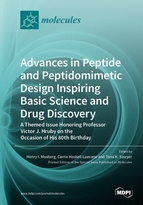Advances in Peptide and Peptidomimetic Design Inspiring Basic Science and Drug Discovery: A Themed Issue Honoring Professor Victor J. Hruby on the Occasion of His 80th Birthday
A special issue of Molecules (ISSN 1420-3049). This special issue belongs to the section "Medicinal Chemistry".
Deadline for manuscript submissions: closed (31 March 2019) | Viewed by 91908
Special Issue Editors
Interests: GPCR; opioids; bifunctional ligands; peptidomimetics
Interests: peptide and proteomimetic chemistry; GPCR, kinase, protease and protein–protein interaction drug discovery; medicinal chemistry; structure-based design; cell permeability
Interests: GPCR; neuropeptide; peptide; obesity; feeding behavior; melanocortin; melanotropin
Special Issue Information
Dear Colleagues,
Fueled by a wide-ranging, probing curiosity complemented by an energetic, engaging personality and a highly collaborative approach to science, Prof. Victor J. Hruby’s research accomplishments have spanned a staggering breadth of scientific endeavors resulting in well over 1300 publications, numerous patents, and a worldwide reputation as a preeminent scholar.
Victor was born in Valley City, North Dakota and received his B.S. and M.S. degrees with A. William Johnson at the University of North Dakota. He then went to Cornell University for graduate studies with A. T. Blomquist. After receiving his Ph.D., Dr. Hruby joined the Cornell University Medical College as an Instructor, working with Prof. Vincent duVigneaud, Nobel Laureate. He moved to the University of Arizona in 1968 as an Assistant Professor and rose through the academic ranks to be Regents Professor in the Department of Chemistry and Biochemistry in 1989. He is now Emeritus Regents Professor and has remained very active in both mentoring and collaborative work at the University of Arizona and throughout the world.
Prof. Hruby’s many accomplishments include: (i) the rational design of novel, extensively used and highly cited ligands for opioid, melanocortin, oxytocin, glucagon, and neurokinin receptors; (ii) the development and application of approaches for incorporating conformational constraints into peptides to improve selectivity and bioavailability and to aid elucidation of bioactive conformations; and (iii) key contributions to combinatorial chemistry, and the application of biophysical methods (e.g., NMR, X-ray crystallography, fluorescence, Plasmon waveguide resonance spectroscopy) to the determination of biomolecular structure and mechanism.
Molecules is highly pleased to host a Special Issue honoring Prof. Victor J. Hruby on the occasion of his 80th birthday for his outstanding achievements to advance peptide and peptidomimetic design, as well as inspire both basic science and drug discovery.
Prof. Henry Mosberg
Dr. Tomi Sawyer
Prof. Carrie Haskell-Luevano
Guest Editors
Manuscript Submission Information
Manuscripts should be submitted online at www.mdpi.com by registering and logging in to this website. Once you are registered, click here to go to the submission form. Manuscripts can be submitted until the deadline. All submissions that pass pre-check are peer-reviewed. Accepted papers will be published continuously in the journal (as soon as accepted) and will be listed together on the special issue website. Research articles, review articles as well as short communications are invited. For planned papers, a title and short abstract (about 100 words) can be sent to the Editorial Office for announcement on this website.
Submitted manuscripts should not have been published previously, nor be under consideration for publication elsewhere (except conference proceedings papers). All manuscripts are thoroughly refereed through a single-blind peer-review process. A guide for authors and other relevant information for submission of manuscripts is available on the Instructions for Authors page. Molecules is an international peer-reviewed open access semimonthly journal published by MDPI.
Please visit the Instructions for Authors page before submitting a manuscript. The Article Processing Charge (APC) for publication in this open access journal is 2700 CHF (Swiss Francs). Submitted papers should be well formatted and use good English. Authors may use MDPI's English editing service prior to publication or during author revisions.
Keywords
- Peptide
- peptidomimetic
- macrocyclic peptides
- conformationally-constrained peptides
- receptor targets
- structural biology
- biophysical chemistry
- computational modeling
- structure-activity, opioids
- melanocortins
- oxytocin
- glucagon
- neurokinins









